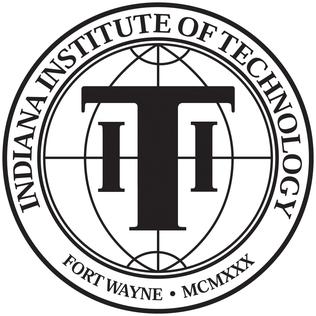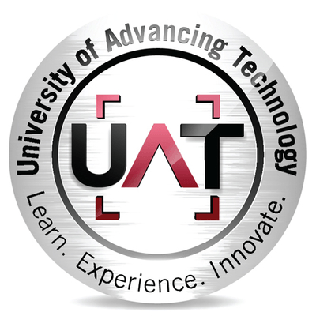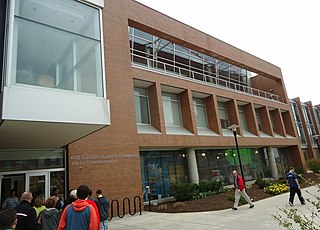
An engineering technologist is a professional trained in certain aspects of development and implementation of a respective area of technology. An education in engineering technology concentrates more on application and less on theory than does an engineering education. Engineering technologists often assist engineers; but after years of experience, they can also become engineers. Like engineers, areas where engineering technologists can work include product design, fabrication, and testing. Engineering technologists sometimes rise to senior management positions in industry or become entrepreneurs.
Engineering management or Management Engineering is applied engineering. It is the application of engineering methods, tools, and techniques applied to business management systems. Engineering management is a career that brings together the technological problem-solving ability of engineering and the organizational, administrative, legal and planning abilities of management in order to oversee the operational performance of complex engineering-driven enterprises. Careers positions include engineering manager, project engineer, product engineer, service engineer, process engineer, equipment engineer, maintenance engineer, field engineer, technical sales engineer, quality and safety engineer. Universities offer bachelor degrees in engineering management. Programs cover courses such as engineering management, project management, operations management, logistics, supply chain management, engineering law, value engineering, quality control, quality assurance, six sigma, quality management, safety engineering, systems engineering, engineering leadership and ethics, accounting, applied engineering design, business statistics and calculus. A Master of Engineering Management (MEM) is sometimes compared to a Master of Business Administration (MBA) for professionals seeking a graduate degree as a qualifying credential for a career in engineering management.

The Florida Institute of Technology is a private research university in Melbourne, Florida. The university comprises four academic colleges: Engineering & Science, Aeronautics, Psychology & Liberal Arts, and Business.Approximately half of FIT's students are enrolled in the College of Engineering & Science. The university's 130-acre primary residential campus is near the Melbourne Orlando International Airport and the Florida Tech Research Park. The campus is located 16 miles from Patrick Space Force Base. The university was founded in 1958 as Brevard Engineering College to provide advanced education for professionals working in the U.S. space program at the Kennedy Space Center and Space Launch Delta 45 at Cape Canaveral Space Force Station. Since 1966, when it combined the Institute of Technology (FIT) following University of Central Florida's name change, FIT has gone by its current name Florida Tech. In 2021, Florida Tech had an on-campus student body of 5,693 between its Melbourne Campus, Melbourne Sites, and Education Centers, as well as 3,623 students enrolled in their online programs, almost equally divided between graduate and undergraduate students with the majority focusing their studies on engineering and the sciences. Florida Tech is classified among "R2: Doctoral Universities – High research activity".

Indiana Institute of Technology is a private university in Fort Wayne, Indiana. It was founded in 1930 as Indiana Technical College by John A. Kalbfleisch, who was also the school's first president.
Capitol Technology University is a private university in South Laurel, Maryland, near Washington, DC. The university was founded in 1927 as the Capitol Radio Engineering Institute by a former US Navy Radioman. CREI changed its name to Capitol Institute of Technology in 1964, changed its name again to Capitol College in 1987, and assumed its present name in 2014. Capitol offers undergraduate and graduate programs specializing in engineering, computer science, information technology, and business. It is classified among "Special Focus Institutions—Schools of Engineering" and is a National Center of Academic Excellence in Information Assurance Education.

Polytechnic of Porto - School of Engineering (ISEP) is a public polytechnic higher learning and research engineering institute, located in the city of Porto, Portugal. ISEP is divided in 8 departments, with an emphasis on applied science and technology.

Mapúa University, also known simply as Mapúa or MU, is a private research-oriented non-sectarian university located in Metro Manila, Philippines. The university was founded in 1925 by the first registered Filipino architect, Tomás Mapúa, a graduate of Cornell University in New York, US. In 2000, the university was acquired by the Yuchengco Group of Companies.
The Sydney Accord is an international mutual recognition agreement for qualifications in the fields of engineering technology.

University of Advancing Technology (UAT) is a private for-profit university in Tempe, Arizona. Founded in 1983, UAT integrates technology into its general education requirements. The institution offers core classes, as well as deep sets of courses in each major. Each student is required to complete a "Student Innovation Project" and internship to graduate.
The National Institute for Certification in Engineering Technologies (NICET) is an organization that was established in 1961 to create a recognized certification for engineering technicians and technologists within the United States. A 1981 study by the National Cooperative Highway Research Program (NCHRP), requested by the American Association of State Highway and Transportation Officials' SubCommittee On Construction (AASHTO SCOC), prompted the National Society of Professional Engineers (NSPE) to merge two certification bodies; the Institute for the Certification of Engineering Technicians (ICET) and the Engineering Technologist Certification Institute. The result is a nonprofit organization that provides a nationally recognized and accepted procedure for recognition of qualified engineering technicians and technologists.

The Technological Institute of the Philippines is one of the country’s engineering colleges that also offers programs in computing, architecture, business, education, and the arts. The school is located in Metro Manila, Philippines. It is a private non-sectarian stock school founded on February 8, 1962, by a group of educators headed by Demetrio A. Quirino, Jr. and Teresita U. Quirino.

Electrical/Electronics engineering technology (EET) is an engineering technology field that implements and applies the principles of electrical engineering. Like electrical engineering, EET deals with the "design, application, installation, manufacturing, operation or maintenance of electrical/electronic(s) systems." However, EET is a specialized discipline that has more focus on application, theory, and applied design, and implementation, while electrical engineering may focus more of a generalized emphasis on theory and conceptual design. Electrical/Electronic engineering technology is the largest branch of engineering technology and includes a diverse range of sub-disciplines, such as applied design, electronics, embedded systems, control systems, instrumentation, telecommunications, and power systems.

Engineering education is the activity of teaching knowledge and principles to the professional practice of engineering. It includes an initial education, and any advanced education and specializations that follow. Engineering education is typically accompanied by additional postgraduate examinations and supervised training as the requirements for a professional engineering license. The length of education, and training to qualify as a basic professional engineer, is typically five years, with 15–20 years for an engineer who takes responsibility for major projects.

The Kate Gleason College of Engineering (KGCOE) is the engineering college at the Rochester Institute of Technology. The college is home to all of RIT's engineering programs except for software engineering, which is part of the B. Thomas Golisano College of Computing and Information Sciences. Entering the 2023-24 academic year, the student body consisted of 2,947 students, with 400 graduate students. About 23% of the students were female.
The American Engineers' Council for Professional Development or simply the Engineers' Council for Professional Development (ECPD), established in June 1932, was an engineering professional body dedicated to the education, accreditation, regulation and professional development of the engineering professionals and students in the United States. ECPD grew and has changed its name to ABET, Inc. and its focus solely to accreditation.
Masinde Muliro University of Science and Technology or MMUST, formerly Western University College of Science and Technology, is a non-profit public university in Kenya. The university is named after Masinde Muliro, a Kenyan politician who helped found the institution. It has approximately 25,000 students across its branches: Main Campus and its two satellite campuses, Webuye Campus and Bungoma Campus
CSAB, Inc., formerly called the Computing Sciences Accreditation Board, Inc., is a non-profit professional organization in the United States, focused on the quality of education in computing disciplines. The Association for Computing Machinery (ACM) and the IEEE Computer Society (IEEE-CS) are the member societies of CSAB. The Association for Information Systems (AIS) was a member society between 2002 and September 2009.

Moshe Kam is an American Israeli electrical engineer. He is an engineering educator serving as Distinguished Professor and Dean of the Newark College of Engineering at the New Jersey Institute of Technology. Until August 2014 he served as the Robert G. Quinn Professor and department head of electrical and computer engineering at Drexel University. In 2011, he served concurrently as the 49th president and CEO of IEEE. Earlier he was IEEE's vice president for educational activities (2005–2007) and IEEE's representative director to the accreditation body ABET. Kam is known for his studies of decision fusion and distributed detection, which focus on computationally feasible fusion rules for multi-sensor systems.

Architecture has been closely associated with engineering in the history of the building construction. The engineering for buildings was determined empirically in the early periods; later, scientific calculations for structures were developed in the 17th century, and engineering was taught as a separate course in the 18th century. Architectural engineering was established as a discipline in the formal realm of engineering in the late 19th century when the University of Illinois became the first of many universities to offer an architectural engineering program. The university with the longest ABET accreditation is Pennsylvania State University, which received theirs in 1935.

Geological engineering is a discipline of engineering concerned with the application of geological science and engineering principles to fields, such as civil engineering, mining, environmental engineering, and forestry, among others. The work of geological engineers often directs or supports the work of other engineering disciplines such as assessing the suitability of locations for civil engineering, environmental engineering, mining operations, and oil and gas projects by conducting geological, geoenvironmental, geophysical, and geotechnical studies. They are involved with impact studies for facilities and operations that affect surface and subsurface environments. The engineering design input and other recommendations made by geological engineers on these projects will often have a large impact on construction and operations. Geological engineers plan, design, and implement geotechnical, geological, geophysical, hydrogeological, and environmental data acquisition. This ranges from manual ground-based methods to deep drilling, to geochemical sampling, to advanced geophysical techniques and satellite surveying. Geological engineers are also concerned with the analysis of past and future ground behaviour, mapping at all scales, and ground characterization programs for specific engineering requirements. These analyses lead geological engineers to make recommendations and prepare reports which could have major effects on the foundations of construction, mining, and civil engineering projects. Some examples of projects include rock excavation, building foundation consolidation, pressure grouting, hydraulic channel erosion control, slope and fill stabilization, landslide risk assessment, groundwater monitoring, and assessment and remediation of contamination. In addition, geological engineers are included on design teams that develop solutions to surface hazards, groundwater remediation, underground and surface excavation projects, and resource management. Like mining engineers, geological engineers also conduct resource exploration campaigns, mine evaluation and feasibility assessments, and contribute to the ongoing efficiency, sustainability, and safety of active mining projects













